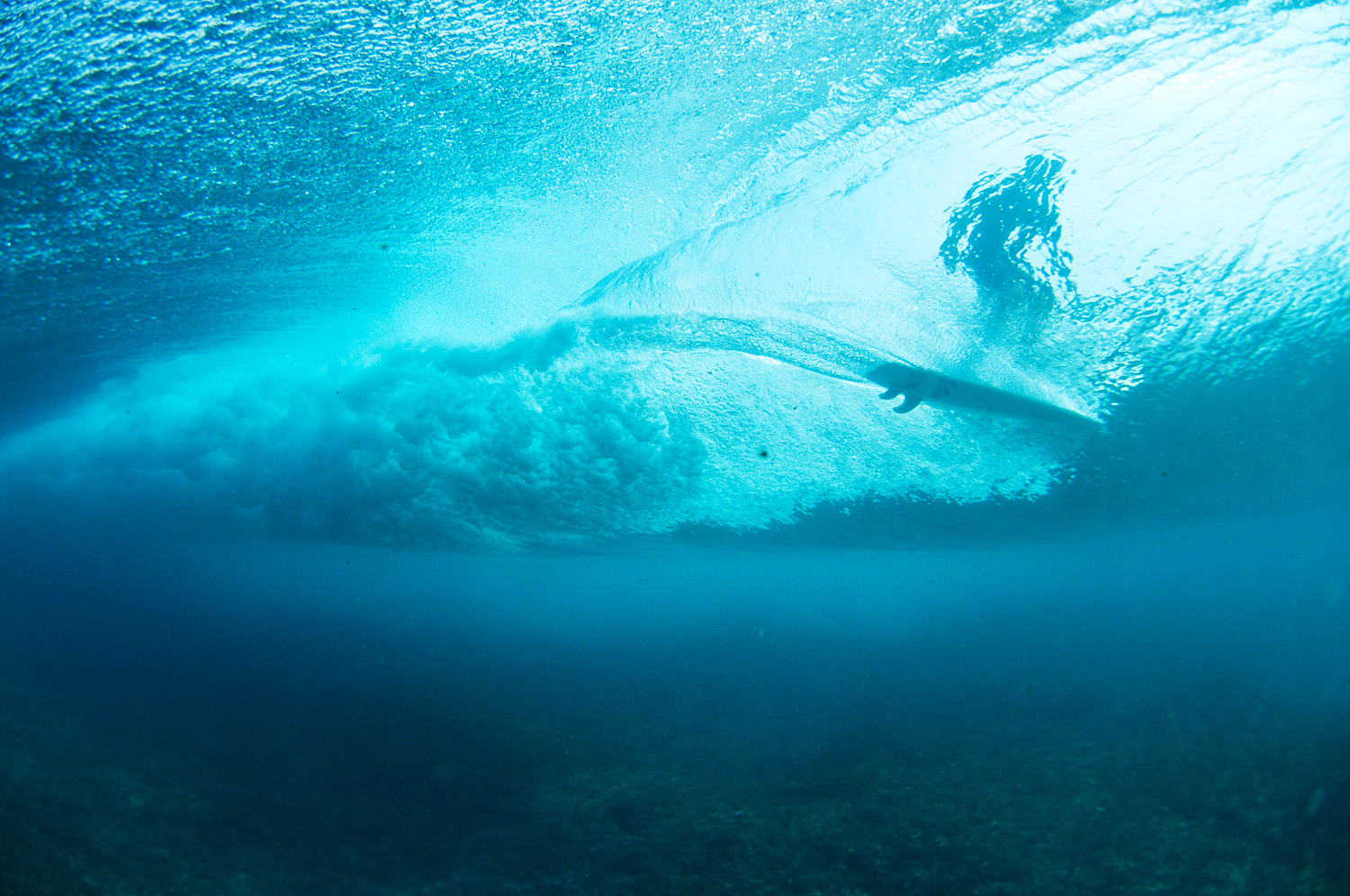Words Joel Menzies
I watched as my hands tapped on a keyboard, flights flashing across the screen. I was having an outer body experience watching from above as my hands booked flights to Indo paradise. I’d just worked a week of night shifts. Before that I’d surfed my body and brain into oblivion for 21 days straight. It was probably just delirium from fatigue, but I saw the forecast. I had to go back.
Every surfer knows what it’s like. You know you’re going to score. You know it’s going to be pumping. Your whole body shivers in anticipation. Sleep is something that can happen on planes and cars on the way to perfection.
Through the looking glass many surfers appear to have an addiction, one that we will often make physical sacrifices for to achieve. We have a proud history of exploration and travel. Pioneering into disease infested jungles and politically unstable areas.
Given the sacrifices that have been made to score perfect waves, a little reef cut (or even a big one) won’t stop most surfers. That’s why I want to talk about it today because even small cuts can kill you through infection.
 Noa Deane, coral cuts far from mind. Photo: Andrew Shield
Noa Deane, coral cuts far from mind. Photo: Andrew Shield
The official medical advice is once the wound is cleaned, disinfected (and closed if necessary) that it should stay dry until healed.
I’m hearing crickets.
Was that tumbleweed that just rolled across the screen?
I know you are hitting the water. So how about some harm minimisation.
This must be said with the caveat that if you’re rocking a gash that would make the jokers smile look like a dimple or if you’re going to be in the tropics for weeks or months you should definitely treat that wound with respect. Let it fully heal as infections from these cuts can become very heavy.
Failed to punch through a doggy door on low tide and left some skin on the reef, what to do?
1. This may be obvious but – if it’s bleeding – stop it. Direct pressure on the bleeding area and elevation if it’s a limb should be adequate in most situations. Fortunately the majority of our scrapes involve a bit of skin loss, but fin chops, or penetrating board injuries have the potential to cause significant bleeding. So if your pissing blood like Mike Tyson kidney punched you, use plenty of pressure and seek medical assistance ASAP.
2. The sooner you get out of the water and clean the wound, the less chance of infection. Cleaning is the most important step. Use fresh clean water and soap and give that wound a good wash out and rub/scrub. You don’t want any tiny bits of coral or any other foreign matter in there. It hurts like a bitch but is soooooo necessary. Explore the wound and make sure there are no hidden bits of coral or dirt in there. A brand new toothbrush is a good item to have (never use a crusty toothbrush unless you want to breed a mutant army of gingivitis bugs that could take over the world).
3. When you think you have got it really clean and washed out, keep going.
4. And going some more.
Our favourite surf Doc, Joel Menzies, absolutely ripping at Ulus this last strike mission. Onya Doc!
5. If there are loose/dead bits of scrappy skin that won’t come together nicely, it is best to trim with some sterile scissors and get rid of it. Dead flappy skin will trap dirt and bugs and increase the likelihood of infection.
6. There is a raft of anecdotal evidence behind many and varied antiseptics for coral cuts. Diluted hydrogen peroxide, dilute iodine solutions, alcohol solutions, the brown “Chinese medicine” in Indo, Lemons and Limes. Researching this article I could find no clear evidence base for any of them being superior. (If anyone wants to get involved in a research project with me and is happy to throw themselves over 6ft low tide speedies maybe we can get the evidence base!)
The point being – whatever you have available as an antiseptic – you should use it! If I was going to recommend anything it would be 50/50 hydrogen peroxide and water, mainly because I like watching the fizz!
7. Now you need to decide whether the wound should be left open or closed. The majority of our reef scrapes are quite superficial and require no steri strips or sutures. There are a few exceptions.
Protect vital structures – if the cut is over a joint, if it is exposing any tendon, ligaments or bone, bring the skin together with steris or sutures, bandage and seek medical attention immediately. Some cuts (usually fin chops) are left gaping, and need closure.
If you have any numbness or change in sensation or ability to move the affected part of your body you also need to seek medical attention immediately.
Taking the above points into account, suturing wounds closed should be avoided if possible. The chance of infection is very high for a sutured wound as bugs become trapped and your body loses its mechanism to discharge them in a purulent protest.
8. Cover the wound with a dressing.
All of the above is pretty reasonable, and most surfers will have no problems with the cleaning. It’s the next step where harm minimisation comes in.
lk  Underneath that glassy perfection, there’s potential for a whole world of hurt. Noa Deane, shot by Andrew Shield.
Underneath that glassy perfection, there’s potential for a whole world of hurt. Noa Deane, shot by Andrew Shield.
If you want a wound to heal the fastest and not get infected you need to stay out of the water and keep it dry.
If you are on a quick strike for the swell, or you’ve just dropped 20 billion rupiah on a boat trip, even though your Doctor told you to keep it dry, we know you are getting wet!
Before hitting the water, cover the wound. Wack a waterproof dressing over the top and you’re laughing. If that’s not available or possible some Vaseline over the wound can work to. It may also provide great amusement for the line up if you get it on your board and do the splits on wave of the day.
Once out of the water you need to clean it thoroughly again, dry it, and put some antibiotic ointment on and cover the wound. You may get away with this for a while, but eventually you will have to stay out of the water to let it heal.
When to Worry?
The big concern is infection, and its’ potential to spread from the wound throughout your whole body.
Things to watch out for are:
Increasing redness around the wound
A line of redness tracking away from the wound
Swelling and pain around the site
If it develops a discharge or is becoming purulent with puss
If you experience fevers, or start feeling excessively fatigue
If you develop any of the above features, seek medical attention immediately – you need antibiotics. And this time seriously stay out of the water until the infection resolves and your wound completely heals. I have seen plenty of surfers’ very sick stuck in hospital on IV antibiotics from wound infections like this.
Sooooooooo having said all that the forecast for tomorrow is looking epic and I’ve got a few wounds to tend to……
Stay tuned for the next check in from Doctor Joel Menzies – if you have any questions or topic requests, let us know below and we’ll get a prescription drawn up! To read his last post on how to deal with Dengue Fever and other viruses, click here.
And if you’re diggin’ the Shieldsy’s Noa photos, we’ve got an exclusive feature profile on Mr Deane in our Indonesia Issue, which you can check out here.
 The lesser seen side of Noa Deane. Photo by Andrew Shield
The lesser seen side of Noa Deane. Photo by Andrew Shield



